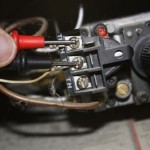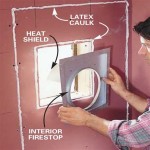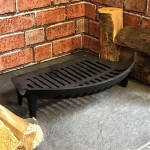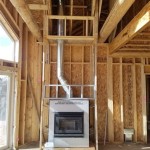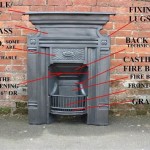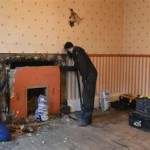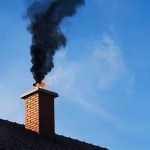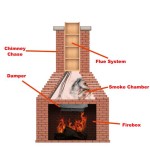Blower Fans for Fireplace Inserts: Enhancing Heating Efficiency and Comfort
Fireplace inserts offer an efficient way to heat a home, providing a focused source of warmth while minimizing heat loss through the chimney. However, the natural convection of heat from a fireplace insert can be slow and uneven, leading to temperature imbalances within a room and even between different areas of a house. A blower fan, specifically designed for fireplace inserts, addresses this limitation by actively circulating heated air, distributing warmth more rapidly and evenly.
A blower fan, also known as a circulation fan or a heat distribution fan, is an auxiliary component installed with a fireplace insert to enhance its heating performance. It operates by drawing cool air from the surrounding environment, passing it over the heated surfaces of the insert, and then forcefully expelling the warmed air back into the room. This forced-air circulation accelerates the heating process and promotes a more uniform temperature distribution, contributing to increased comfort and energy efficiency.
Key Advantages of Using Blower Fans with Fireplace Inserts
Several significant advantages are associated with using blower fans in conjunction with fireplace inserts. These benefits range from improved heating efficiency to enhanced comfort and control.
Enhanced Heating Efficiency: A primary advantage is the improved heating efficiency. Without a blower fan, the heat generated by the fireplace insert relies primarily on natural convection to distribute warmth. This process is inherently slow, and a significant portion of the heat may rise directly to the ceiling, resulting in a warmer upper room and cooler lower sections of the house. A blower fan overcomes this limitation by actively circulating the heated air, forcing it to mix with the cooler air in the room. This forced convection process ensures that the heat is distributed more quickly and evenly, minimizing temperature gradients and maximizing the overall heating efficiency of the fireplace insert. By distributing the heat more effectively, the blower fan allows the user to maintain a comfortable temperature setting with less fuel consumption, leading to potential energy savings. The fan also aids in extracting more heat from the insert itself, preventing the unit from simply radiating heat upward and losing a significant portion of its potential output.
Improved Room Temperature Uniformity: Uneven temperature distribution is a common issue when relying solely on natural convection for heating. Areas closer to the fireplace insert tend to be significantly warmer than those farther away, leading to discomfort and inefficient heating. A blower fan mitigates this problem by actively circulating the heated air, ensuring that it reaches all corners of the room. By forcing the warm air to mix with the cooler air in distant areas, the blower fan creates a more uniform temperature profile, eliminating hot and cold spots and creating a more comfortable and consistent living environment.
Increased Comfort and Control: Blower fans offer users greater control over their heating environment. Many blower fans are equipped with adjustable speed settings, allowing users to customize the airflow and heat output to their specific needs and preferences. This level of control is particularly beneficial during periods of fluctuating temperatures or when different areas of the house require varying levels of heating. Furthermore, the faster heating provided by a blower fan allows users to quickly achieve their desired temperature, reducing the waiting time for the room to warm up. This immediate gratification contributes to increased comfort and satisfaction.
Types of Blower Fans for Fireplace Inserts
Various types of blower fans are available for fireplace inserts, each designed with distinct features and performance characteristics. Understanding these differences is crucial in selecting the appropriate blower fan for a specific fireplace insert and heating needs.
Standard Blower Fans: These are the most common type of blower fan and typically come pre-installed with the fireplace insert or are available as an accessory from the manufacturer. They are usually designed to fit specific models of fireplace inserts and are engineered for optimal performance and compatibility. Standard blower fans are generally powered by a standard electrical outlet and offer adjustable speed settings. They are often the most cost-effective option and provide a reliable and efficient means of circulating heated air.
Aftermarket Blower Fans: These blower fans are designed to be compatible with a wider range of fireplace insert models. They offer greater flexibility in terms of installation and performance customization. Aftermarket blower fans may offer features such as variable speed control, thermal overload protection, and noise reduction technologies. When selecting an aftermarket blower fan, it is important to carefully consider the compatibility with the specific fireplace insert model, ensuring proper fitment and optimal performance. It's vital to review specifications regarding airflow (measured in cubic feet per minute - CFM) and noise levels (measured in decibels - dB) to find a suitable match.
Inline Blower Fans: These fans are installed within the ductwork connected to the fireplace insert, rather than directly on the unit itself. This configuration can be advantageous in situations where space constraints are a concern or when a more discreet installation is desired. Inline blower fans are typically more powerful than standard blower fans, capable of moving large volumes of air over longer distances. They are often used in conjunction with ductwork to distribute heated air to multiple rooms or throughout an entire house. Installation may require professional assistance.
Factors to Consider When Choosing a Blower Fan
Selecting the right blower fan for a fireplace insert involves considering several key factors to ensure optimal performance, compatibility, and safety.
Fireplace Insert Compatibility: The most crucial factor is the compatibility of the blower fan with the specific model of fireplace insert. Ensure that the blower fan is designed to fit the insert's dimensions and that its electrical specifications (voltage and amperage) are compatible with the insert's power supply. Consulting the manufacturer's specifications or seeking advice from a qualified technician is recommended to avoid compatibility issues.
Airflow Capacity (CFM): The airflow capacity of the blower fan, measured in cubic feet per minute (CFM), indicates the volume of air the fan can move in a given time. A higher CFM rating generally indicates a more powerful fan capable of distributing heat over a larger area. The appropriate CFM rating depends on the size of the room or area to be heated. A larger room will require a higher CFM rating to ensure adequate air circulation and even heating. It's advisable to consult the manufacturer's recommendations or seek professional guidance to determine the appropriate CFM rating for a specific space. Overly powerful fans can create drafts, while underpowered fans may not adequately distribute heat.
Noise Level (dB): The noise level of the blower fan, measured in decibels (dB), is an important consideration, particularly for noise-sensitive individuals. Blower fans can generate noise due to the motor and the movement of air through the fan blades. Selecting a blower fan with a low dB rating can minimize noise disturbance and create a more comfortable environment. Many blower fans are equipped with noise reduction technologies to minimize operational noise. Reading product reviews and seeking recommendations from other users can provide valuable insights into the actual noise levels of different blower fan models.
Variable Speed Control: The ability to adjust the speed of the blower fan is a desirable feature that allows users to customize the airflow and heat output to their specific needs and preferences. Variable speed control allows for fine-tuning the heating performance based on the temperature outside, the desired comfort level, and the size of the space being heated. Blower fans with variable speed control typically offer multiple speed settings or a continuous adjustment knob, providing greater flexibility and control over the heating environment.
Thermal Overload Protection: Thermal overload protection is a safety feature that prevents the blower fan from overheating, which can potentially damage the fan or the fireplace insert. This protection typically involves a temperature sensor that automatically shuts off the fan if it exceeds a pre-determined temperature threshold. Thermal overload protection enhances the safety and reliability of the blower fan, preventing potential hazards and ensuring the longevity of the equipment.
Energy Efficiency: While the primary purpose of a blower fan is to enhance heating efficiency, it is also important to consider the energy consumption of the fan itself. Look for blower fans with energy-efficient motors and designs that minimize power consumption. Energy-efficient blower fans can help reduce overall energy costs and minimize the environmental impact of heating a home.
Installation Considerations: While some blower fans are relatively easy to install, others may require professional installation. Consider the complexity of the installation process and whether specialized tools or expertise are required. Improper installation can lead to performance issues, safety hazards, or damage to the fireplace insert. If unsure, it is recommended to seek assistance from a qualified technician.
By carefully considering these factors, selecting the appropriate blower fan for a fireplace insert can significantly enhance heating efficiency, improve comfort, and create a more enjoyable living environment.

Pleasant Hearth Circulating Blower For Zero Clearance Ventless Dual Fuel Fireplace Inserts Zcb100 The Home Depot

Fireplace Efficiency Blowers And Why You Should Have One

Noisy Gas Fireplace Blower Here S How To Replace It Diy

Wood Fireplace Inserts With Blowers Upgrade Your

Fireplace Blower Fan For Regency Insert 910 157 P Hampton Hi300 H2100 I2400 Wo

Fireplace Blower Fan For Regency Insert 910 157 P Hampton Hi300 H2100 I2400 Wo

Style Selections Blower Fan For Gas Fireplace Inserts At Com

5 Blades Wood Stove Fan Anodized Aluminum Thermoelectric Wf Hw59002 The Home Depot

How To Replace Your Rsf Fireplace Blower Fan

MorsØ 5660 Fireplace Insert With Fan Honest Home
Related Posts

